Scientists used a 200-ton “neutrino scale” to measure the elusive particles.



Time crystals that persist indefinitely at room temperature could have applications in precision timekeeping.
We have all seen crystals, whether a simple grain of salt or sugar, or an elaborate and beautiful amethyst. These crystals are made of atoms or molecules repeating in a symmetrical three-dimensional pattern called a lattice, in which atoms occupy specific points in space. By forming a periodic lattice, carbon atoms in a diamond, for example, break the symmetry of the space they sit in. Physicists call this “breaking symmetry.”
Scientists have recently discovered that a similar effect can be witnessed in time. Symmetry breaking, as the name suggests, can arise only where some sort of symmetry exists. In the time domain, a cyclically changing force or energy source naturally produces a temporal pattern.
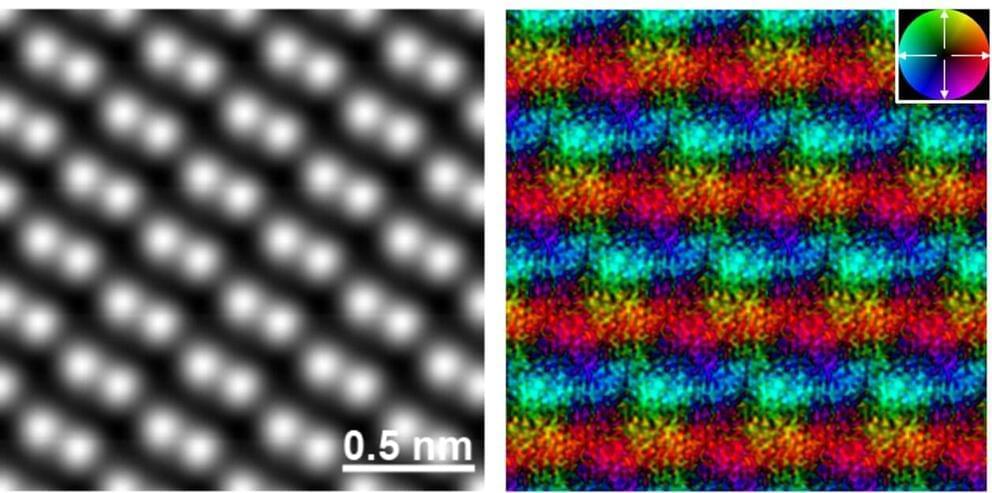
The joint development team of Professor Shibata (the University of Tokyo), JEOL Ltd. and Monash University succeeded in directly observing an atomic magnetic field, the origin of magnets (magnetic force), for the first time in the world. The observation was conducted using the newly developed Magnetic-field-free Atomic-Resolution STEM (MARS). This team had already succeeded in observing the electric field inside atoms for the first time in 2012. However, since the magnetic fields in atoms are extremely weak compared with electric fields, the technology to observe the magnetic fields had been unexplored since the development of electron microscopes. This is an epoch-making achievement that will rewrite the history of microscope development.
Electron microscopes have the highest spatial resolution among all currently used microscopes. However, in order to achieve ultra-high resolution so that atoms can be observed directly, we have to observe the sample by placing it in an extremely strong lens magnetic field. Therefore, atomic observation of magnetic materials that are strongly affected by the lens magnetic field such as magnets and steels had been impossible for many years. For this difficult problem, the team succeeded in developing a lens that has a completely new structure in 2019. Using this new lens, the team realized atomic observation of magnetic materials, which is not affected by the lens magnetic field. The team’s next goal was to observe the magnetic fields of atoms, which are the origin of magnets (magnetic force), and they continued technological development to achieve the goal.
This time, the joint development team took on the challenge of observing the magnetic fields of iron (Fe) atoms in a hematite crystal (α-Fe2O3) by loading MARS with a newly developed high-sensitivity high-speed detector, and further using computer image processing technology. To observe the magnetic fields, they used the Differential Phase Contrast (DPC) method at atomic resolution, which is an ultrahigh-resolution local electromagnetic field measurement method using a scanning transmission electron microscope (STEM), developed by Professor Shibata et al. The results directly demonstrated that iron atoms themselves are small magnets (atomic magnet). The results also clarified the origin of magnetism (antiferromagnetism) exhibited by hematite at the atomic level.
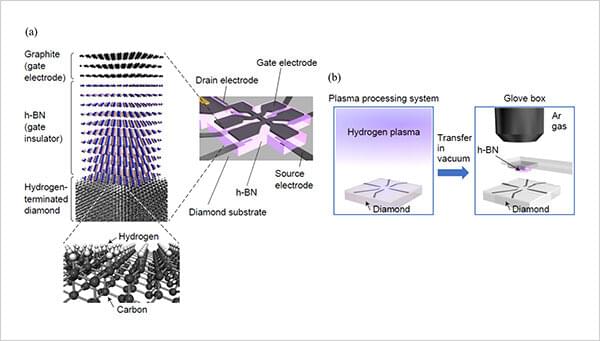
Using a new fabrication technique, NIMS has developed a diamond field-effect transistor (FET) with high hole mobility, which allows reduced conduction loss and higher operational speed. This new FET also exhibits normally off behavior (i.e., electric current flow through the transistor ceases when no gate voltage is applied, a feature that makes electronic devices safer). These results may facilitate the development of low-loss power conversion and high-speed communications devices.
Diamond has excellent wide bandgap semiconductor properties: its bandgap is larger than those of silicon carbide and gallium nitride, which are already in practical use. Diamond therefore could potentially be used to create power electronics and communications devices capable of operating more energy efficiently at higher speeds, voltages and temperatures. A number of R&D projects have previously been carried out with the aim of creating FETs using hydrogen-terminated diamonds (i.e., diamonds with their superficial carbon atoms covalently bonded with hydrogen atoms). However, these efforts have failed to fully exploit diamonds’ excellent wide bandgap semiconductor properties: the hole mobility (a measure of how quickly holes can move) of these diamond-integrated transistors was only 1–10% that of the diamonds before integration.
The NIMS research team succeeded in developing a high-performance FET by using hexagonal boron nitride (h-BN) as a gate insulator instead of conventionally used oxides (e.g., alumina), and by employing a new fabrication technique capable of preventing the surface of hydrogen-terminated diamond from being exposed to air. At high hole densities, the hole mobility of this FET was five times that of conventional FETs with oxide gate insulators. FETs with high hole mobility can operate with lower electrical resistance, thereby reducing conduction loss, and can be used to develop higher speed and smaller electronic devices. The team also demonstrated normally-off operation of the FET, an important feature for power electronics applications. The new fabrication technique enabled removal of electron acceptors from the surface of the hydrogen-terminated diamond.
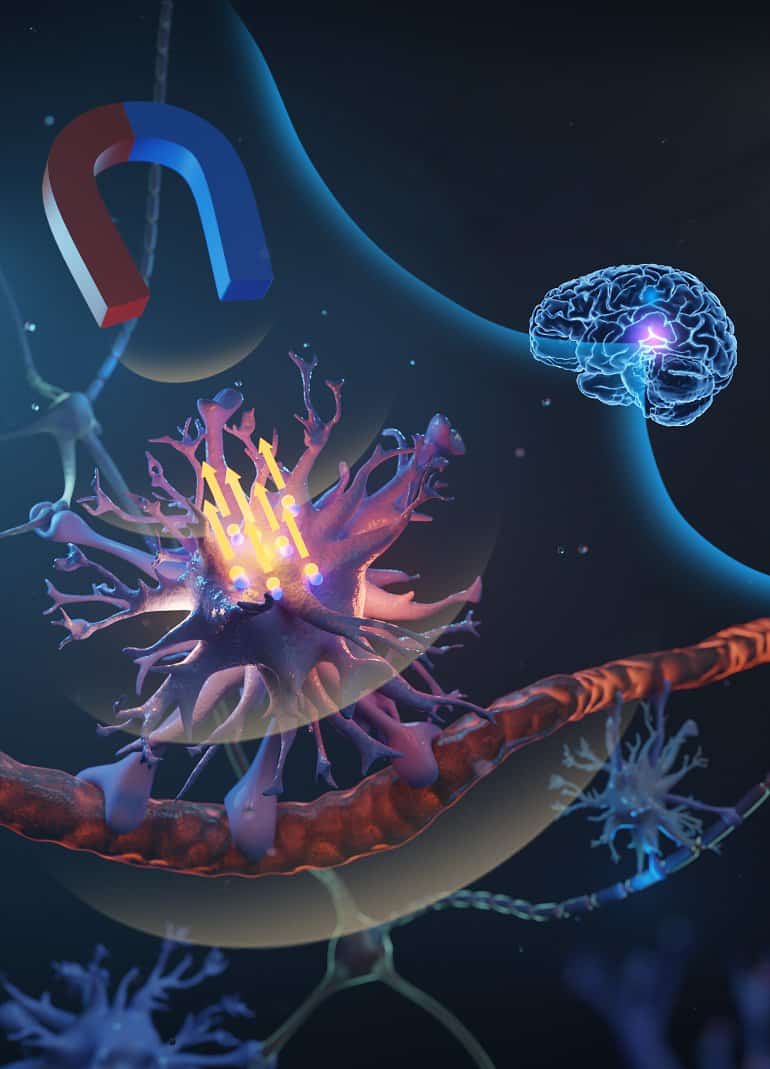
Summary: A newly developed technique allows researchers to remotely active neurons with the aid of microscopic magnetic particles.
Source: UCL
Scientists at UCL have developed a new technique that uses microscopic magnetic particles to remotely activate brain cells; researchers say the discovery in rats could potentially lead to the development of a new class of non-invasive therapies for neurological disorders.
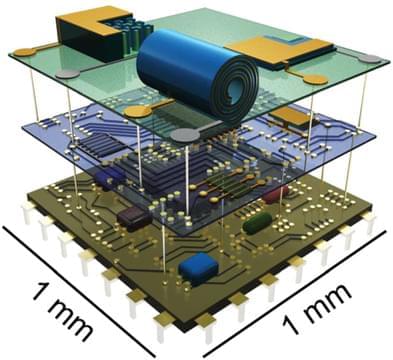
And it’s the size of a grain of dust. Energy storage might have been revolutionized thanks to a common dessert dish.
Advances in microelectronics have enabled the use of miniaturized computers for autonomous intelligence at the size of a dust particle less than one square millimeter across and a few hundred micrometers thick, creating an environment for ubiquitous computing. However, the size mismatch between microbatteries and microelectronics has emerged as a fundamental barrier against the take-off of tiny intelligent systems requiring power anytime anywhere. Mainstream microbattery structures include stacked thin films on the chip or electrode pillars and on-chip interdigitated microelectrodes. Nevertheless, available technologies cannot shrink the footprint area of batteries while maintaining adequate energy storage. Alternatively, the on-chip self-assembly process known as micro-origami is capable of winding stacked thin films into Swiss-roll structures to reduce the footprint area, which exactly mimics the manufacture of the most successful full-sized batteries—cylinder batteries. In addition to discussing in detail the technical difficulties of reducing the size of on-chip microbatteries with various structures and potential solutions, this Perspective highlights the following two basic requirements for eventual integration in microcomputers: minimum energy density of 100 microwatt-hour per square centimeter and monolithic integration with other functional electric circuits on the chip.


Yesterday, LHCb submitted for publication new results of matter-antimatter oscillations using decays of charm particles, significantly improving the current experimental knowledge!
Read our news: https://lhcb-outreach.web.cern.ch/2022/02/21/high-precision-…ht-mesons/
Today, the LHCb Collaboration submitted for publication a paper that reports the results of the high precision measurement of the charm oscillation (mixing) parameter yCP – yCPKπ using two body D0 meson decays. The result is more precise than the current world average value by a factor of four.
The neutral meson particle-antiparticle systems, Bs0−Bs0, B0–B0, D0–D0 and K0–K0 oscillate (transform into their antiparticle and back) with very different frequencies. The Bs0−Bs0 oscillations are the fastest, about 3 million million times per second (3×1012). The oscillations B0–B0 are about 37 times slower while the oscillations D0–D0 are even slower; the oscillation period is over one hundred times larger than the average lifetime of a D0 meson. Therefore only very few D0 mesons have the time to oscillate before decaying.
The quantum mechanical treatment of neutral charm meson oscillations leads to two neutral mesons, D1 and D2, each with their own mass, m1 and m2, and typical lifetime represented by their decay width, Γ1 and Γ2. The D0-D0 oscillations are described by the two dimensionless parameters, x=(m1-m2)/Γ, determining the frequency of oscillations, and y=(Γ1-Γ2)/Γ, in which Γ is the average width, (Γ1+Γ2)/2.
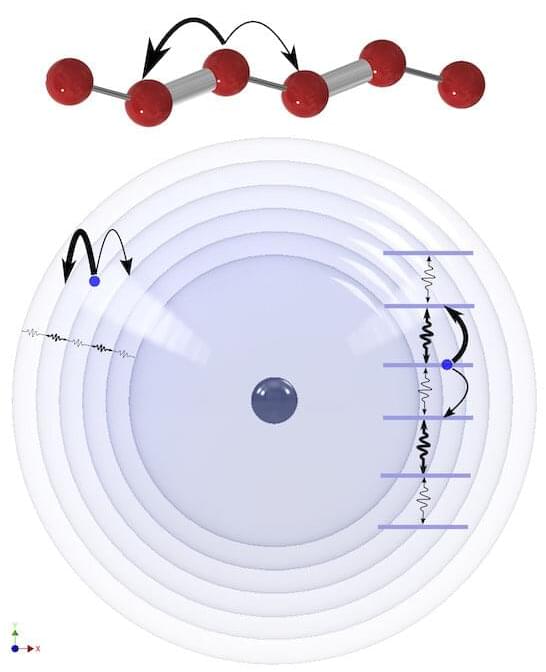
Our spatial sense doesn’t extend beyond the familiar three dimensions, but that doesn’t stop scientists from playing with whatever lies beyond.
Rice University physicists are pushing spatial boundaries in new experiments. They’ve learned to control electrons in gigantic Rydberg atoms with such precision they can create “synthetic dimensions,” important tools for quantum simulations.
The Rice team developed a technique to engineer the Rydberg states of ultracold strontium atoms by applying resonant microwave electric fields to couple many states together. A Rydberg state occurs when one electron in the atom is energetically bumped up to a highly excited state, supersizing its orbit to make the atom thousands of times larger than normal.
Ion channels are crucial for neural communication; they control the flow and gradient of charged particles, creating electrical signals. Recent work report | Neuroscience.
In this study, the researchers assessed how dense ion channels were packed in the membranes of neuronal cells from ten species of mammals, including mice, rats, rabbits, ferrets, macaques, marmosets, macaques, humans, and one of the smallest known mammals, an animal called the Etruscan shrew. The team focused on a type of excitatory neuron typically found in the cortex of the brain, and three ion channels that are in the membranes of those cells; two are voltage-gated ion channels that control the movement of potassium, another is called the HCN channel and both potassium and sodium ions can flow through it.
Studies have suggested that the human brain is built like the brains of other mammals, said first study author Lou Beaulieu-Laroche, a former MIT graduate student. It was once thought that in mammals, these channels would be present at about the same density from one species to another.
Instead, the researchers determined that as the neurons got bigger, the density of ion channels increased. That was a notable finding, because as that density increases, more energy needed to move ions in and out of neurons, explained senior study author Mark Harnett, an associate professor of brain and cognitive sciences at MIT.